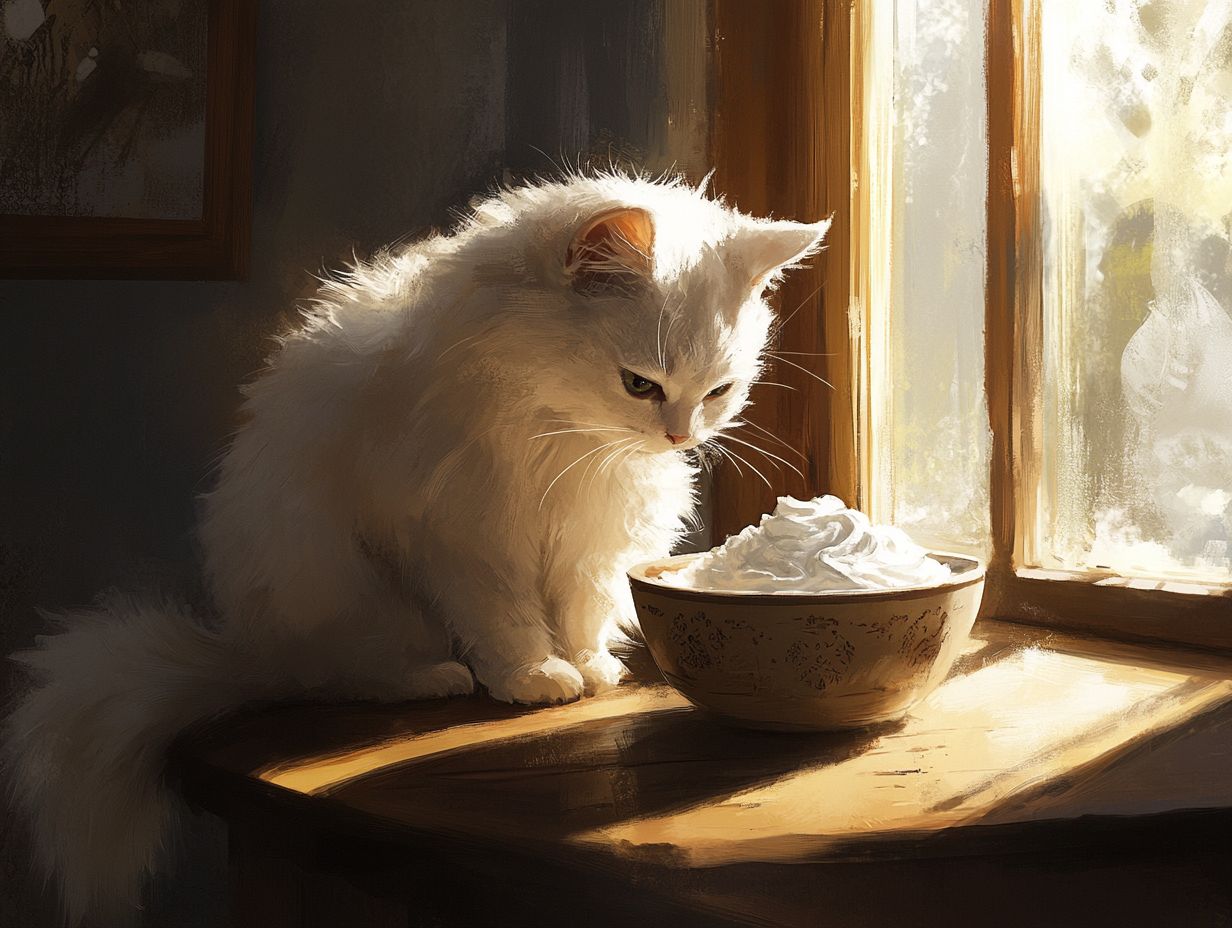Cats are unique pets with specific dietary needs that pet owners often strive to meet. Understanding cat nutrition is essential for ensuring optimal health and overall pet care.
One common question is: Can cats eat whipped cream? While it might seem like a delightful treat, it’s crucial to consider the dietary requirements and potential health issues associated with such indulgence.
This article will guide you through the nutritional needs of cats, safe alternatives, and ways to offer whipped cream as a special treat, ensuring your furry friend stays healthy while enjoying occasional surprises.
Key Takeaways:

- Cats’ nutritional needs and daily caloric intake should be carefully considered before feeding them any human food.
- Whipped cream may pose potential risks to cats. Use moderation—like a half-teaspoon for a small cat or one teaspoon for a larger cat.
- There are many alternative, healthier treat options for cats that can satisfy their cravings without risking their health.
Understanding Cats’ Nutritional Needs
Understanding a cat’s dietary and nutritional needs is essential for keeping them healthy. As meat eaters, cats require a diet high in animal protein to meet their energy and nutrient requirements.
This diet must be carefully balanced, considering factors such as the cat’s age, weight, and any specific medical conditions that might influence their food intake. The Cornell Feline Health Center is a valuable resource for pet owners looking to comprehend their cat’s dietary needs.
What Cats Need in Their Diet
Cats need a balanced diet rich in high-quality animal products, including protein sources like turkey and salmon, to support their health. Essential vitamins and minerals found in various meats and fish are also crucial for their vitality.
Offering high-value treats can create bonding opportunities when given in moderation. However, it’s vital that these treats complement a balanced diet and do not replace it. An inadequate diet can lead to significant health issues, including obesity, which can exacerbate conditions such as diabetes.
Therefore, understanding a cat’s specific dietary needs is essential for enhancing their overall well-being.
How to Introduce New Treats Safely
When considering new treats for your cat, start by introducing small amounts to monitor their reaction. Be sure to consult your veterinarian for personalized dietary advice.
Whipped Cream: Risks and Benefits
Many pet owners wonder if cats can eat whipped cream, especially when considering it as a special treat for their furry companions.
While the creamy texture and taste of whipped cream may be appealing to some cats, it’s essential to understand the dietary implications and potential health risks, particularly for those that are lactose intolerant.
Additionally, whipped cream is high in fat and calories, which must be considered regarding their daily caloric intake.
Potential Risks and Benefits

Whipped cream can be an enjoyable treat for some cats; however, it is important to weigh the risks against the benefits. One significant risk is that many cats are lactose intolerant, which can lead to digestive issues like diarrhea or vomiting. The high fat content in whipped cream can also contribute to obesity.
For more information, check out Can Cats Eat Whipped Cream? What You Need to Know.
While a small spoonful given on a special occasion can serve as a reward, ensure it does not replace a balanced diet. Healthier alternatives or low-lactose options can provide enjoyment while minimizing risks.
Healthy Treat Alternatives
For those seeking alternatives to whipped cream, consider options like low-lactose yogurt, pureed pumpkin, or commercially available cat treats that cater to a cat’s dietary needs. Always ensure these alternatives fit into their daily caloric intake.
In conclusion, while whipped cream can be tempting, prioritizing your cat’s health is essential. Consult a veterinarian for dietary concerns and explore safe alternatives that will keep your cat happy and healthy.
Frequently Asked Questions
Can cats eat whipped cream?
While cats can technically eat whipped cream, it is not advised as a regular part of their diet due to its high sugar and fat content.
What happens if my cat eats whipped cream?

If your cat eats a small amount of whipped cream occasionally, it is unlikely to cause harm. However, large amounts can lead to digestive issues.
What are the health risks of feeding my cat whipped cream?
Regularly feeding whipped cream can lead to obesity, diabetes, and other health issues. Cats do not need sugary or fatty treats.
What are safe portion sizes for cat treats?
A teaspoon of whipped cream or yogurt is an appropriate portion size for an occasional treat. Always consult your veterinarian for tailored advice.
Are there any alternatives to whipped cream for my cat?
Yes, safer alternatives include small amounts of plain yogurt, freeze-dried meat treats, or specially formulated cat treats.
Benefits of Safe Treats for Cats
Offering safe treats like yogurt can provide beneficial probiotics that support your cat’s digestive health and serve as a tasty reward.
Risks of Harmful Ingredients
Whipped cream may contain harmful additives, such as xylitol, which is toxic to cats and can cause serious health issues.
What should I do if my cat accidentally eats whipped cream?
If your cat consumes whipped cream, monitor for signs of digestive distress. Immediate veterinary attention is necessary if symptoms like vomiting or diarrhea occur.
Guidelines for Safe Treating
To ensure safe feeding, always consult with a veterinarian before introducing new foods. Stick to recommended portion sizes and observe your cat for any adverse reactions.
In conclusion, while cats can enjoy safe treats like plain yogurt in moderation, avoid potentially harmful foods like whipped cream. Always prioritize your cat’s health and consult veterinary sources for guidance.